|
Lt Douglas Adshead-Grant.
Combined Operations Headquarters
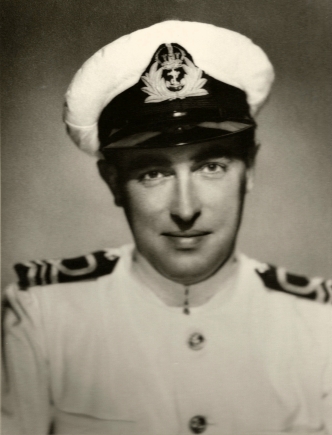 Background Background
Lt Douglas Adshead-Grant
will be remembered as the man who designed the ubiquitous Combined Operations
badge in early 1942. However, Churchill and the Joint Chiefs of
Staff, seeing other wartime applications for
his artistic talent and lively imagination, recruited him to the heart of the
Command, as explained below. He was later promoted Lieutenant Commander.
Lt Grant was an accomplished sketcher/illustrator
and a qualified architect. It was his sketching skills and fertile imagination
that produced ideas
for a badge for the newly formed Combined Operations Command. It depicted the Army, Navy and Air Force working together
as a unified fighting unit on amphibious operations against the enemy. His design
of the badge
endures to this day in many parts of the
world.
Other ideas relating to the conduct of the war, which he and others
conjured up, were often difficult to describe in words alone. His graphical
interpretations significantly improved understanding and helped high ranking decision
makers in their deliberations. He was recruited to the Combined Operations Command Headquarters
(COHQ) and
accompanied Churchill and Mountbatten to the Quebec Conference in 1943.
Operation Ambassador
He
was not one for the back office. In 1940, he served on the Command
Operations Base in Warsash, codenamed
HMS
Tormentor and became involved in early small-scale combined operations
against enemy occupied territory,
wo rking with the actor, David Niven. rking with the actor, David Niven.
Lt Grant
took part in a an early amphibious raid on
German-occupied Guernsey, codenamed Operation Ambassador, which took place on
the night of 14/15 July 1940. Beaching and un-beaching proved more difficult
than expected due to tidal conditions and during the withdrawal, one of the
dinghies got into difficulties. Lt Grant saved the life of one of the raiding
party as he floundered in the sea. His swift humanitarian action was recognised
by the award of the Honorary Testimonial of the Royal Humane Society.
This period,
in the development of the Commandos, was a learning process.
"Pin-prick" raids, of this type, often produced little or no military gain.
However, it was a process from which much more effective raiding operations
emerged through improved intelligence, planning, training and equipment. Lessons
were learned.
Mulberry Harbours
At the time of the Quebec
Conference, there was much debate with the
Americans about providing sheltered harbours for a large scale amphibious
invading force near to the landing beaches. Ideas included sunken ships,
concrete caissons, concrete pontoons, collapsible canvas floating barriers and
Pykrete. There was, unsurprisingly, scepticism on both sides
of the Atlantic with some believing that Mulberry was an even more fanciful idea than Pykrete
ships! To overcome the doubters in his ranks, Mountbatten called a meeting in
one of the bathrooms of the Queen Mary.
As they entered the bathroom, they saw a partially filled
bath, 40 or so ships made out of newspaper and a Mae West lifebelt. Half the 'fleet' was placed in the
bath and the most junior officer present in the crowded bathroom, Lt Commander
Grant, RN, was asked to make waves with the back of a brush. In no time, the
vessels sank. The demonstration was repeated, this time with the 'fleet' floating
inside the Mae West. To the immortal command "More waves please, Lieutenant
Grant", the heavily braided onlookers saw that all the vessels survived.
No doubt Lt Grant's involvement in
this demonstration was much greater than just making waves. It was a convincing
practical demonstration that conveyed more powerfully than a thousand words, the
benefits of breakwaters in the protection of vessels where traditional harbours
were not available.
Operation Habakkuk
Lt Grant worked on Operation Habakkuk with Max F Perutz and
Dr Geoffrey Pyke in a secret
meat freezing store underneath the Smithfield Meat Market in London. With the
aid of electrically heated suits to keep them warm, the team mixed wooden pulp
with water (later called Pykrete) and froze the mix in a wind tunnel to test the
feasibility of building an ice ship. They fired shots into the material to test
its resilience.
In 1943,
Churchill was sufficiently impressed to approve plans for a prototype
ice-ship to be drawn up in Washington DC and
he
ordered Douglas to
accompany him on the Queen Mary
to attend the Quebec Quadrant Conference in the Frontenac Hotel. Douglas's
architectural plans were accepted and he was retained in Washington as Technical
Officer. Although a small prototype ice-ship was
constructed
on Patricia Lake, near Jasper, Alberta, the project was
abandoned for a number of reasons,
including the high cost of steel needed for
the refrigeration.
Family Archive

Taken from the minutes of
a meeting chaired by Prime Minister Churchill at 10 Downing St on the
10th June 1943 at 12 noon. Present amongst those attending was Lt DA
Grant from Combined Operations Headquarters.
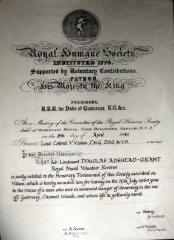
Lt Grant saved the life of a comrade when
on a Commando style operation off Guernsey in the Channel Islands. This
Royal Humane Society certificate was awarded in recognition of a
selfless and courageous act.
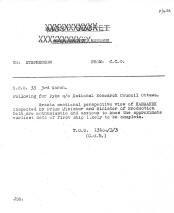
This previously classified
"MOST SECRET" memo informs Geoffrey Pyke,
the man behind the Ice Ships idea, that Lt
Grant's sectional illustrations of the completed craft had been
inspected and heartily approved of by Churchill.
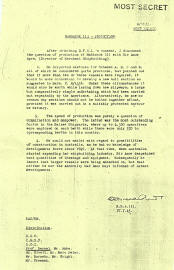
In this MOST SECRET memo
to the Chief of the Combined Operations Command and others interested,
including scientists, Lt Grant clarifies some production issues.
After the war,
Lt Commander Grant returned to his architecture practice at 40 Norland Square, London
W11, where he was involved in the feasibility studies for London’s Airports,
which was a hotly contested issue at the time. The redesign of Lynmouth, after the
devastating floods of 1952, was another significant project he was involved
in. Lt Commander Grant died in 1956 at the young age of
42, leaving behind a widow, a son (15) and a daughter (13). An incisive
obituary, written by the headmaster of Silcoates School, in the village of Wrenthorpe, near Wakefield, which Lt
Commander Grant attended for 8 years, is
reproduced below.
Obituary from Silcoation October
1956
Douglas
Adshead-Grant joined us in 1922 and spent
eight full, lively, happy years at the school. In 1930 he left us, but never ceased
to belong - those who had been his teachers simply became his friends, and again
and again he returned, always cheerful, always welcome.
His after-school life falls
into three parts, pre war, war and post war. In part one he was preparing,
cultivating his remarkable gifts, finding his way to beautiful art and
construction. He took his degree, B. Arch,. at the famous Liverpool School of
Architecture, and in 1936 was elected ARIBA. To our Architectural Exhibition in
Hall (March 1937) he contributed a mass of fine work, his wonderful line
drawings being specially admired. (To my amazement at such results in view of so
great an economy of line he simply replied: "I go out on a two or three hours
tramp at night and when I get back, I find I have reduced 6 lines to 5!") In
partnership with
Professor Adshead he was making a name for himself in London, when the war
cried "Halt" to all such craftsmen.
His labours were now changed, but greatly and
strangely multiplied. At first he was found among those who on moonless
nights with blackened faces, made midnight flittings to the shores of France,
accomplished their "Commando" project and then raced back to Dover in a fast
motor boat. It was a life of high adventure and he revelled in it. Once it meant
for him swimming for a long time off the Channel Islands in the dark, until a
destroyer happily located him and picked him up.
In
1943 his higher service, of which we learnt nothing during the whole period of
the war (he told me it was "all very secret, confidential and hush hush"),
began. He had plans with regard to submarine losses and was interviewed in
Downing St by the War Cabinet and questioned at length by Mr Churchill, who soon
ordered him to go with him to the Quebec Conference. There, in the Frontenac
Hotel, he gave a demonstration before the Combined Imperial General Staff. He
was interviewed several times by both Roosevelt and Churchill, his plans were
accepted and he was retained in Washington as Technical Officer. I believe at
this time that his brother, Donald, hitchhiked over 1000 miles from Canada to
see him. (Donald, alas, was one of the precious lads snatched from us in the
last months of that appalling war).
Later, Douglas was attached to the Combined
Operations HQ and was present at the daily meetings of the Chiefs of Staff, who
made constant use of his exceptional talents in drawing to express their, and
his own, ideas. His modesty did not permit him to tell even his family of the
nature of his appointment, and in the years that followed he never alluded to
those experiences unless specially asked to do so.
In part 3 of his too short life he had the chance
of entering Government service, but he preferred to be free and built up a
 fine private practice in London and elsewhere. He erected factories in Birmingham and
in Lancashire, a Congregational church at Pulborough, a church hall at Knebworth
and above all, what he loved most, beautiful, roomy, comfortable houses. fine private practice in London and elsewhere. He erected factories in Birmingham and
in Lancashire, a Congregational church at Pulborough, a church hall at Knebworth
and above all, what he loved most, beautiful, roomy, comfortable houses.
[Lt Grant's grandson Ed and mother, Jill, visiting
the memorial in August 2021].
He had not seen a doctor in years, but on a
Saturday in February he came down to his little Kent cottage, and after a
specially happy tea-time took his wife out for a drive. After five minutes he
complained of a pain in the chest. They just managed to get back home when he
collapsed, and was gone in a few minutes. He had worked at high pressure for too
long. He was 42. He has left a wife, a boy of 15 and a girl of 13.
He was the last of the four sons whose loss those
missionary heroes, Rev John and Mrs Grant, have had to suffer. They all have our
sympathy, our admiration, our love. Douglas was a great and worthy son of
Silcoates. He has shown how much can be accomplished by a life in which genius is
wedded to hard work, to truth and beauty.
Sydney H Moore, Headmaster 1918 - 1943.
 Professor Stanley Davenport Adshead was Lt
Grant's uncle, who was at that time, professor of town planning at London
University.
Lt Grant's daughter, Jacky, now resides in Vancouver and
his late son, Donald (1940-1996), shared his father’s sense of adventure by
serving 40 years in the Merchant Navy. Professor Stanley Davenport Adshead was Lt
Grant's uncle, who was at that time, professor of town planning at London
University.
Lt Grant's daughter, Jacky, now resides in Vancouver and
his late son, Donald (1940-1996), shared his father’s sense of adventure by
serving 40 years in the Merchant Navy.
In August 2021, Lt.
Grant's grandson, Ed Adshead-Grant and his mother, Jill, visited the Combined
Operations memorial for the first time and added these photos and comments to
the CO Facebook page. They are a fitting conclusion to the remarkable story of
his grandfather's wartime service.
"Paying respects to the Combined Operations
Command, where (my Grandfather) Lt.Commander Douglas Adshead-Grant worked in
WWII and designed the insignia still in use today around the world - fascinating
character who sadly I never met."
Further Reading
There are around 300 books listed on
our 'Combined Operations
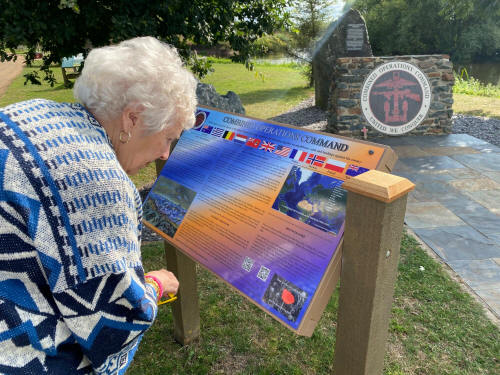 Books' page. They, or any
other books you know about, can be purchased on-line from the
Advanced Book Exchange (ABE). Their search banner link, on our 'Books' page, checks the shelves of
thousands of book shops world-wide. Just type in, or copy and paste the
title of your choice, or use the 'keyword' box for book suggestions.
There's no obligation to buy, no registration and no passwords. Books' page. They, or any
other books you know about, can be purchased on-line from the
Advanced Book Exchange (ABE). Their search banner link, on our 'Books' page, checks the shelves of
thousands of book shops world-wide. Just type in, or copy and paste the
title of your choice, or use the 'keyword' box for book suggestions.
There's no obligation to buy, no registration and no passwords.
Already included as links in the above text are early
designs and development of the Combined
Operations badge,
specimens of badges
from WW2 to the modern era
and
photos of the
badge in use.
Acknowledgements
 It
is 73 years since Lt Douglas Adshead-Grant designed the Combined Ops badge and
15 years since I first appealed for information about him. We
are grateful to his grandson, Ed Adshead-Grant, for providing the information for
this page. [Geoff Slee (2015)]. It
is 73 years since Lt Douglas Adshead-Grant designed the Combined Ops badge and
15 years since I first appealed for information about him. We
are grateful to his grandson, Ed Adshead-Grant, for providing the information for
this page. [Geoff Slee (2015)].
|









